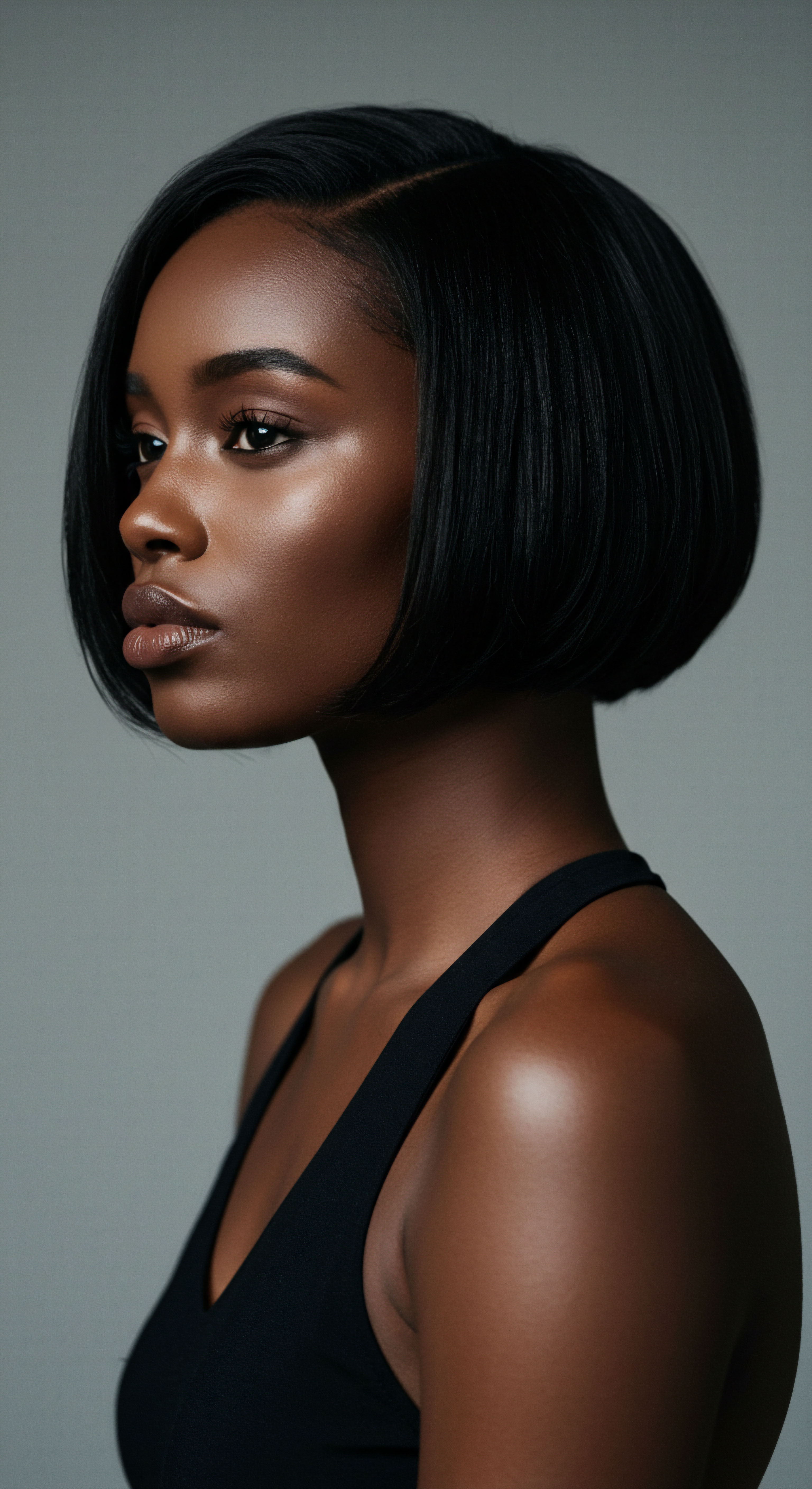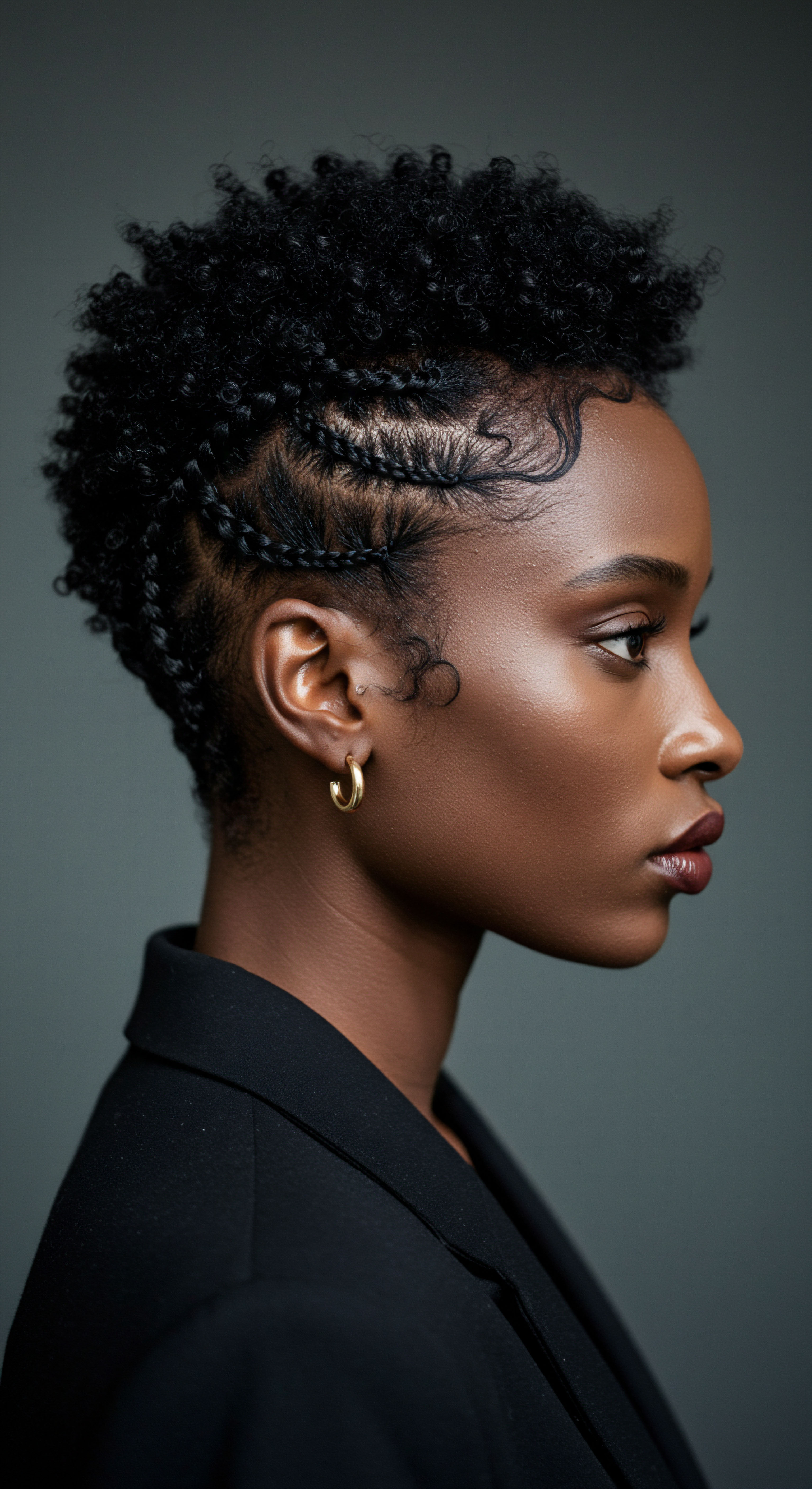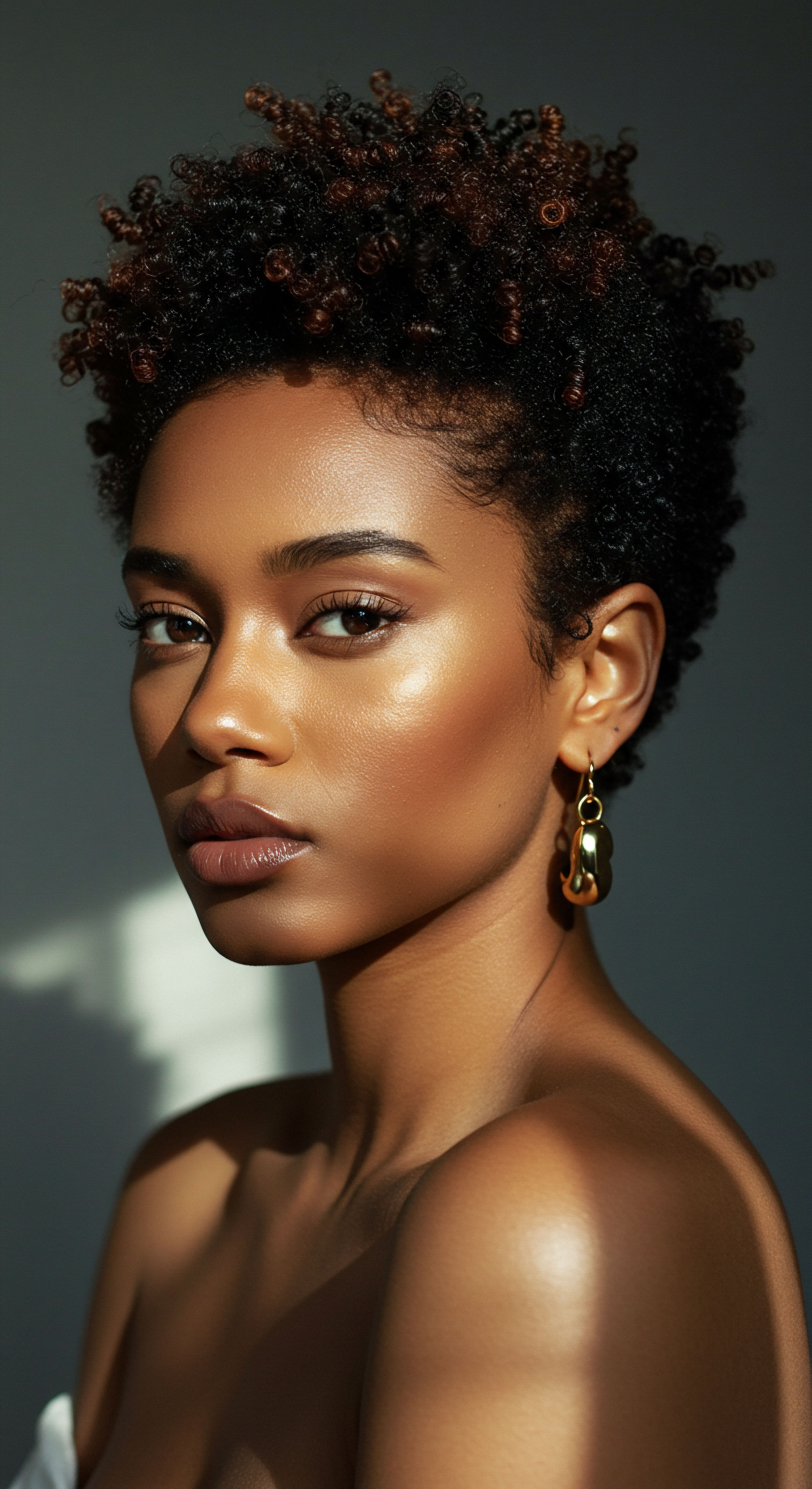
Roots
The quiet hours of slumber, often perceived as a simple cessation of daily activity, hold a profound, often overlooked, connection to the enduring vitality of our hair. Beyond the visible sheen or curl pattern, our strands exist in a delicate conversation with the deeper rhythms of our being. This dialogue extends into the night, where the positions we settle into, the surfaces we rest upon, and the very quality of our repose subtly orchestrate a long-term ballet for our hair’s well-being. To truly comprehend this relationship, we must first descend to the foundational elements, understanding hair not as a mere adornment, but as a living extension of our physiological landscape.

Hair’s Nightly Regeneration Cycle
Each individual hair strand, from its visible shaft to its hidden follicle nestled beneath the scalp, follows a meticulously timed growth cycle. This cycle, comprised of anagen (growth), catagen (transition), and telogen (resting) phases, is a continuous process of renewal and shedding. While we are awake, myriad environmental and mechanical forces interact with our hair. Yet, during sleep, a different set of influences takes prominence, quietly shaping the conditions for hair’s nightly regeneration.
The body prioritizes repair and rejuvenation during these hours, and the hair follicles, too, partake in this restorative work. This nocturnal period is when cells divide most actively, when nutrient delivery is optimized, and when the body works to undo the day’s stressors.
The hours of sleep offer a silent, yet powerful, period of regeneration for hair follicles, setting the stage for long-term strand vitality.

Anatomy and Physiology Specific to Textured Hair
Textured hair, with its unique helical structure, presents distinct considerations in this nightly interaction. The bends and curves along the hair shaft create natural points of vulnerability, making it more susceptible to friction and mechanical stress. The cuticle layers, which act as the hair’s protective outer shield, can lift or chip with repeated rubbing, leading to moisture loss and increased susceptibility to breakage. Furthermore, the scalp, the very ground from which these magnificent strands spring, experiences its own nightly micro-environment.
- Hair Follicle Shape ❉ The elliptical shape of the hair follicle in textured hair types dictates the curl pattern, but also influences how the hair emerges from the scalp, potentially affecting its initial contact points with surfaces during sleep.
- Cuticle Integrity ❉ The naturally raised cuticle of textured hair makes it more prone to snagging and friction damage against rough fabrics, compromising its protective barrier.
- Moisture Retention ❉ The unique structure of textured hair often leads to challenges in retaining moisture, and nighttime practices can either aid or hinder this crucial aspect of hair health.

The Essential Lexicon of Textured Hair and Sleep
Understanding the dialogue between sleep and textured hair health requires a precise vocabulary. Terms like Hygral Fatigue, the weakening of hair from repeated swelling and contracting due to water absorption and drying, become relevant when considering overnight conditioning or damp hair practices. Scalp Microcirculation, the tiny blood vessels that deliver nutrients and oxygen to hair follicles, is influenced by sustained pressure points during sleep.
And Nocturnal Traction, the subtle but continuous pulling forces on hair follicles throughout the night, often stemming from how hair is styled or rested, holds significant weight in long-term hair preservation. These are not merely academic terms; they are signposts guiding us toward a more intentional approach to nighttime hair care.
| Hair Component Hair Shaft |
| Relevance to Sleep Outer layer exposed to friction and pressure. |
| Potential Sleep Posture Impact Abrasion, tangling, cuticle damage. |
| Hair Component Cuticle |
| Relevance to Sleep Protective scales; integrity affects moisture. |
| Potential Sleep Posture Impact Lifting, chipping, leading to moisture loss. |
| Hair Component Hair Follicle |
| Relevance to Sleep Root structure, where growth begins. |
| Potential Sleep Posture Impact Pressure on scalp, restricted blood flow, nocturnal traction. |
| Hair Component Scalp Skin |
| Relevance to Sleep Environment for follicles, blood supply. |
| Potential Sleep Posture Impact Temperature, moisture, pressure points, lymphatic flow. |
| Hair Component Understanding these components helps reveal how sleep posture affects hair's foundational health. |

Ritual
Stepping from the foundational understanding of hair’s architecture into the realm of daily and nightly practices, we find that our sleep rituals, far from being trivial, hold immense sway over the long-term vitality of our hair. It is within these quiet, consistent moments before rest that we can either inadvertently invite compromise or thoughtfully lay the groundwork for enduring hair health. The choices made here, from how we arrange our hair to the textiles that cradle it, form a gentle choreography with significant repercussions. This segment will explore the subtle yet profound ways these nocturnal habits sculpt our hair’s future.

The Nighttime Sanctuary Essential Sleep Protection
The environment where we sleep acts as a sanctuary, yet it can also be a source of stress for our hair. Traditional cotton pillowcases, with their absorbent nature and rough fibers, can draw moisture from the hair, leaving it dry and brittle. This dryness, coupled with the friction generated by movement during sleep, can lead to significant breakage, especially for delicate textured strands. The simple act of changing a pillowcase material transforms this interaction.
- Silk Pillowcases ❉ The smooth surface of silk allows hair to glide, reducing friction and minimizing snagging and tangling. This preservation of the hair’s cuticle helps retain moisture and prevents breakage.
- Satin Pillowcases ❉ A more accessible alternative to silk, satin offers similar benefits in reducing friction and moisture absorption, providing a gentle surface for hair to rest upon.
- Bonnets and Wraps ❉ These protective coverings act as a barrier between hair and pillow, offering comprehensive protection from friction and helping to seal in moisture from nighttime products.

What Less Obvious Benefits Do Hair Coverings Provide?
Beyond the obvious friction reduction, bonnets and wraps offer a less apparent yet significant advantage ❉ they help to maintain a consistent moisture level within the hair. This is particularly beneficial for textured hair, which tends to lose moisture more readily. By creating a micro-climate around the hair, these coverings prevent excessive evaporation, allowing applied products to work more effectively and keeping the hair hydrated throughout the night. This consistent hydration guards against Hygral Fatigue, where the hair repeatedly swells and contracts, leading to weakening over time.
Consider a study published in the Journal of the American Academy of Dermatology, which, while not directly on sleep posture, highlighted the importance of reducing mechanical stress in hair care routines to prevent breakage. While this study primarily discussed daily styling, its underlying principle — that cumulative mechanical stress damages hair — extends directly to the nocturnal environment. The continuous, subtle rubbing against a rough surface, even if it feels gentle, represents a form of mechanical stress that can compound over time, leading to cumulative damage that manifests as thinning or breakage years down the line. The authors of the study, specifically referring to practices that minimize physical stress on the hair shaft, underscore how seemingly minor friction can contribute to significant hair loss over time.
The consistent application of thoughtful nighttime practices creates a protective barrier, shielding hair from the subtle aggressions of sleep.

The Art of Hair Arrangement Before Sleep
How hair is styled before bed also plays a significant role in mitigating stress. Loose, non-restrictive styles that allow hair to retain its natural curl pattern without tension are ideal. A pineapple method (a loose, high ponytail at the crown of the head) or loose braids can minimize friction on the length of the hair while keeping strands contained.
Tightly pulled buns or ponytails, particularly when worn consistently in the same spot, can contribute to Nocturnal Traction, a form of mechanical stress that, over extended periods, can lead to hair thinning along the hairline or at the nape. This subtle, continuous pulling, night after night, can weaken follicles and eventually result in a receding hairline or patches of hair loss.
| Technique Pineapple Method |
| Benefit for Hair Reduces friction on lengths, preserves curl pattern. |
| Considerations for Textured Hair Ideal for longer, looser textures; may require adjustment for shorter hair. |
| Technique Loose Braids/Twists |
| Benefit for Hair Minimizes tangling, protects ends. |
| Considerations for Textured Hair Helps maintain definition; ensure braids are not tight at the root. |
| Technique Bun/Top Knot (loose) |
| Benefit for Hair Keeps hair contained, reduces overall friction. |
| Considerations for Textured Hair Place high on head to avoid direct pressure points; ensure no tension. |
| Technique Silk/Satin Scarf Wrap |
| Benefit for Hair Full coverage protection, maintains moisture. |
| Considerations for Textured Hair Secures hair without tension; learning proper wrapping techniques is key. |
| Technique Gentle preparation minimizes nocturnal stress and preserves hair's integrity. |

Relay
Moving beyond the immediate physical interactions, the interplay between sleep posture and hair health extends into a complex web of biological and physiological processes. The way we position our bodies during sleep does not merely dictate where our hair rubs; it can subtly influence systemic functions that, in turn, affect the very life cycle of our hair. This segment ventures into these deeper, less apparent connections, drawing on scientific insights that illuminate the profound influence of our nocturnal state on long-term hair vitality.

How Does Sleep Posture Influence Scalp Microcirculation?
The network of tiny blood vessels supplying the scalp, known as the Scalp Microcirculation, is crucial for delivering oxygen and nutrients to the hair follicles. These follicles, highly metabolically active, rely on a consistent supply to sustain their growth and regenerative phases. While sleep posture’s direct impact on scalp blood flow is not as widely studied as its effect on cerebral hemodynamics, general principles of fluid dynamics within the body offer insights. For instance, studies on cerebral microcirculation in different head positions indicate that certain postures can influence blood flow and venous drainage in the head region.
A study investigating the effects of head posture on cerebral hemodynamics found that head elevation from a supine position could reduce intracranial pressure, implying shifts in fluid dynamics within the head and neck area. While hair follicles reside superficially, sustained pressure points from certain sleep postures could theoretically impede localized microcirculation, particularly over prolonged periods, leading to suboptimal nutrient delivery to specific areas of the scalp.

The Circadian Rhythm and Hair Follicle Activity
Our bodies operate on a sophisticated internal clock, the circadian rhythm, which governs cycles of wakefulness and sleep, hormone release, and cellular regeneration. This rhythm is not confined to the brain; peripheral tissues, including hair follicles, possess their own molecular clocks that synchronize with the body’s central pacemaker. Research indicates that circadian clock genes play a regulatory role in the hair growth cycle itself.
For instance, a study published in PLOS Genetics reported that mutations in core circadian clock genes, specifically Clock and Bmal1, led to a significant delay in the progression of the hair growth phase in mice. This suggests that disruptions to our natural sleep-wake cycle, potentially exacerbated by irregular sleep postures that compromise sleep quality, could subtly dysregulate the hair follicle’s own internal timing, impacting its ability to cycle through anagen, catagen, and telogen phases efficiently. When the body’s internal clock is out of sync, the delicate balance required for robust hair growth can be disturbed, potentially leading to increased shedding or slower growth over time.
Beyond physical pressure, sleep posture influences hair health through its subtle impact on systemic functions like microcirculation and circadian rhythms.

Hormonal Balance and Sleep Quality
Sleep posture can influence sleep quality, and sleep quality, in turn, profoundly impacts our hormonal landscape. Chronic sleep deprivation, regardless of the direct cause, elevates stress hormones such as Cortisol. Elevated cortisol levels can disrupt the normal hair growth cycle, prematurely pushing hair follicles into the resting (telogen) phase, leading to increased shedding, a condition known as telogen effluvium. A 2022 study, for example, found a notable association between sleep disturbances and severe male pattern baldness, and a 2020 survey linked poor sleep quality to more severe female pattern hair loss, suggesting a systemic connection that goes beyond direct mechanical stress.
Furthermore, deep sleep is when the body releases growth hormones, which are vital for cellular repair and regeneration, including that of hair follicles. Poor sleep quality, which can be influenced by uncomfortable or restrictive sleep postures, can compromise the release of these hormones, indirectly affecting hair growth and repair mechanisms. The relationship is circular ❉ uncomfortable sleep posture can lead to poor sleep, which in turn leads to hormonal imbalances, which then contribute to compromised hair health.
This complex interaction underscores that the effects of sleep posture extend far beyond visible damage. They ripple through our physiology, affecting the very biochemical signals that dictate hair’s long-term strength and presence.
- Cortisol Levels ❉ Sustained high levels due to poor sleep can prematurely shift hair into its resting phase, leading to shedding.
- Growth Hormone Release ❉ Deep sleep is essential for optimal release, which supports hair follicle repair and regeneration.
- Melatonin Production ❉ This hormone, crucial for regulating sleep, also plays a role in the hair growth cycle, with reduced levels potentially impacting hair health.

Scalp Health and Lymphatic Drainage
The scalp’s health is paramount for healthy hair. Lymphatic drainage, the process by which the body removes waste and toxins, is also influenced by body position. While direct research on sleep posture and scalp lymphatic drainage is limited, general principles of lymphatic flow suggest that positions that promote overall circulation and fluid movement could benefit scalp health.
For instance, sleeping with the head slightly elevated might assist in reducing fluid retention in the face and scalp, potentially contributing to a clearer, less congested scalp environment over time. This subtle physiological assistance, while not immediately apparent, contributes to the overall ecosystem that supports robust hair growth.

Reflection
The journey through the subtle interplay between sleep posture and hair health reveals a landscape far richer than simple surface interactions. It invites us to consider our nightly repose not as a passive state, but as an active, quiet partner in the enduring story of our strands. The choices we make as we drift into slumber, from the fabric cradling our heads to the gentle curves of our bodies, ripple through our physiology, touching upon the very rhythms of growth and renewal.
Our hair, particularly textured hair with its unique requirements, stands as a testament to the profound connection between our inner well-being and outer presentation. To honor this connection is to move beyond quick fixes, to cultivate a deeper, more thoughtful relationship with our hair, acknowledging its deep roots in our overall vitality.

References
- 1. Davis-Sivasothy, Audrey. The Science of Black Hair ❉ A Comprehensive Guide to Textured Hair Care. Saja Publishing Company, 2011.
- 2. Chandrashekar, B.S. IADVL Textbook of Trichology. Jaypee Brothers Medical Publishers, 2018.
- 3. Lin, L.L. et al. “Circadian Clock Genes Contribute to the Regulation of Hair Follicle Cycling.” PLOS Genetics, 2011.
- 4. Aratow, M. et al. “Postural responses of head and foot cutaneous microvascular flow and their sensitivity to bed rest.” Aviation, Space, and Environmental Medicine, 1991.
- 5. Simka, M. et al. “Head position during sleep ❉ potential implications for patients with neurodegenerative disorders.” Sleep Advances, 2019.
- 6. Musiał, Claudia. Cosmetological and Medical Trichology. 2025.
- 7. Sleep Research Society. SLEEP. Oxford Academic.
- 8. European Sleep Research Society. Journal of Sleep Research. Wiley.
- 9. Al-Abadie, M.S. “Stress and the Hair Follicle.” Clinical and Experimental Dermatology, 2004.
- 10. Fischer, T.W. et al. “Melatonin directly influences human hair growth and alters hair follicle functions.” Journal of Pineal Research, 2004.